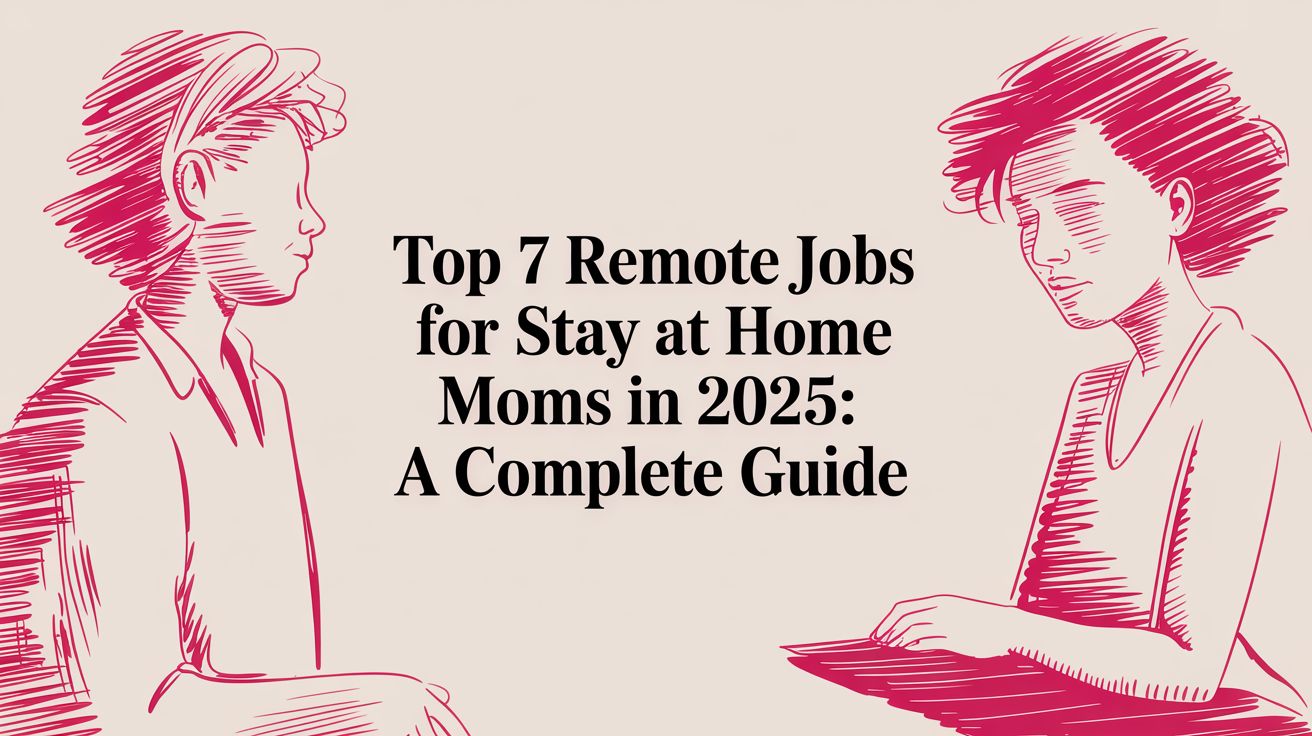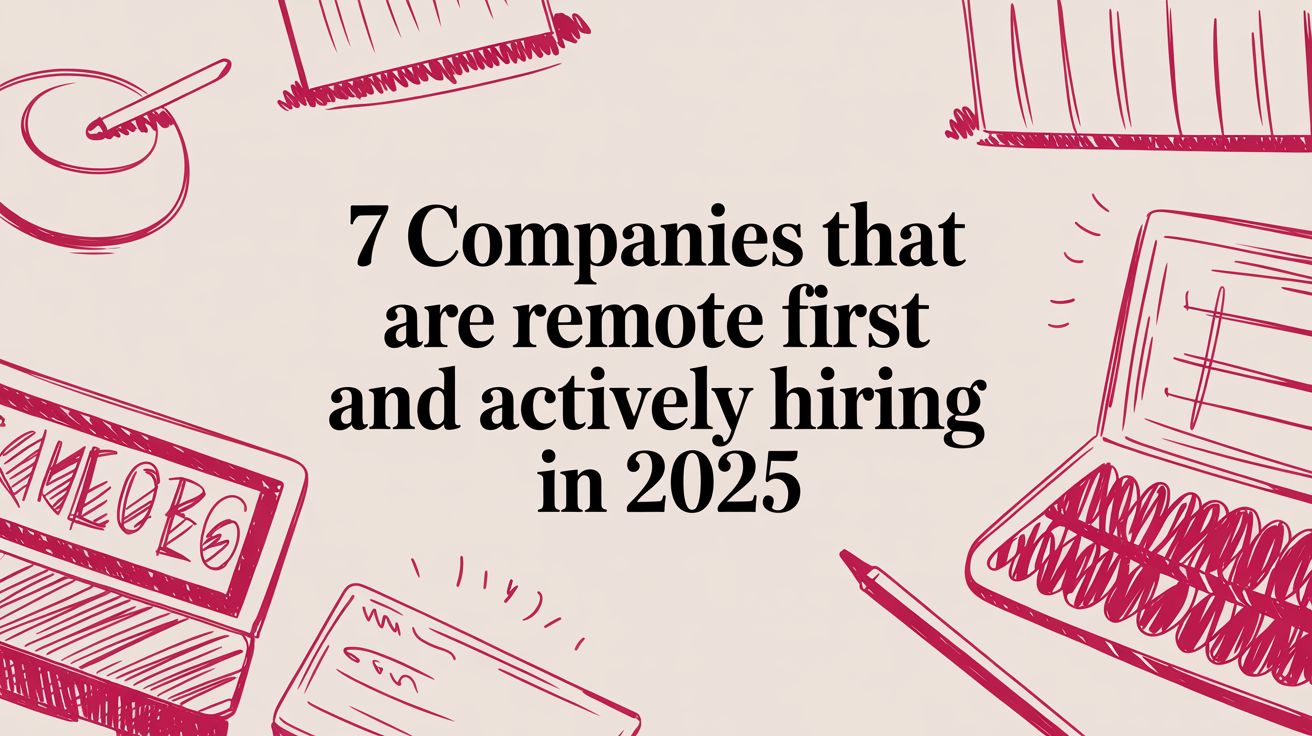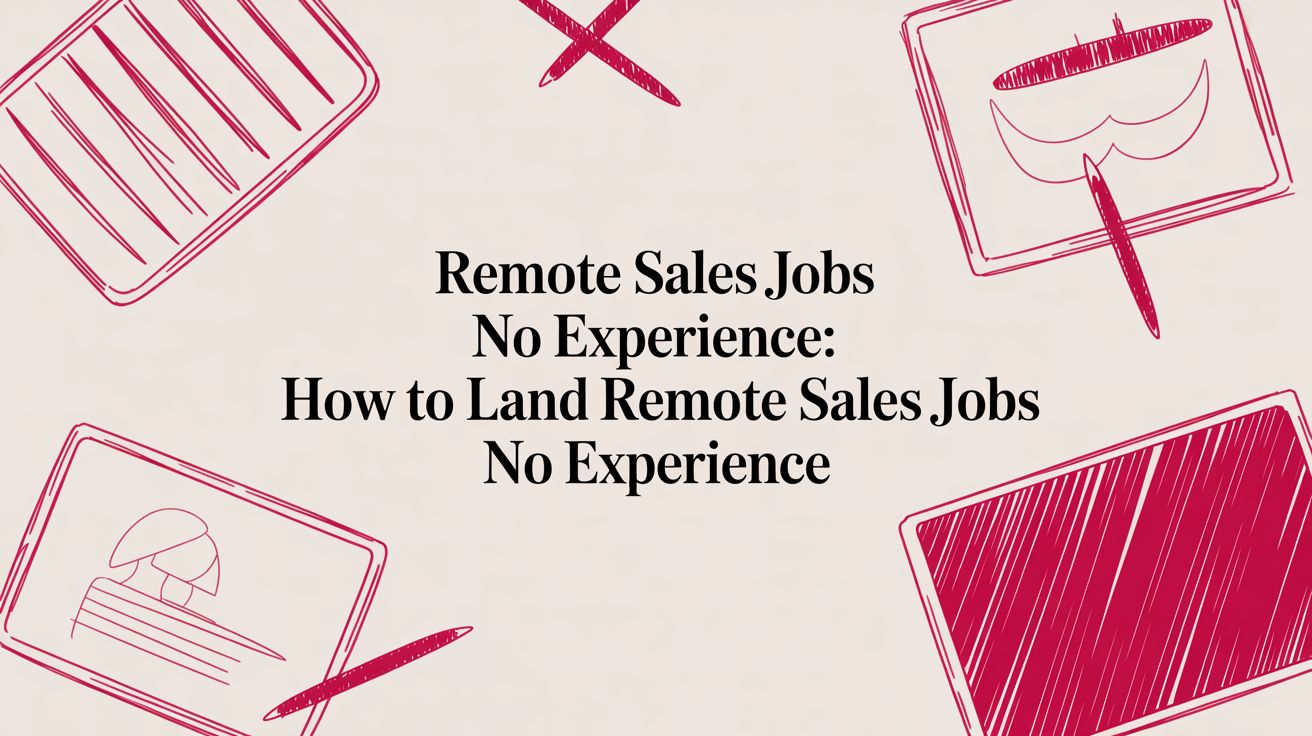What Does Remote First Mean? Discover Its Benefits & How to Thrive
Max
So, what does it really mean when a company calls itself “remote first”?
It’s a commitment, a philosophy baked into the company’s DNA. It means that every process, every piece of communication, and the entire company culture is designed with the remote employee as the default. It’s not an afterthought or an exception to the rule—it’s the foundation of how work gets done.
Defining What Remote First Truly Means

Here’s a good way to think about it: web designers often use a “mobile-first” approach. They design the experience for the smallest screen first and then scale it up for desktops. A remote-first company does the same with its operations, building everything on the assumption that no one is in a central office.
This isn’t just about letting people work from home. It’s a fundamental shift that re-engineers the entire organization from the inside out.
A remote-first model forces companies to get better at the things that matter most: clear communication, excellent documentation, and measuring people by their output, not just by their presence.
This isn’t just a niche trend anymore. By August 2024, 22.8% of employees in the U.S. were already working remotely at least some of the time. The demand is undeniable, with a staggering 91% of employees globally saying they prefer a work model that’s either fully or almost fully remote.
Core Principles of a Remote First Company
To truly understand what separates a remote-first organization from one that simply allows remote work, we need to look at its core principles. These aren’t just policies written in a handbook; they are the lived, daily experiences of the team.
True remote-first companies are built on a few foundational pillars that create an environment where everyone can thrive, no matter where they log in from.
| Principle | Description |
|---|---|
| Asynchronous First | Communication defaults to written formats (like project management tools or shared docs), not real-time meetings. This levels the playing field for team members across different time zones. |
| Single Source of Truth | All vital information—from company policies to project status—is meticulously documented and centrally located. This gets rid of information silos and the “you had to be there” problem. |
| Output Over Hours | Employees are trusted to manage their own schedules. Success is measured by the quality of their contributions and results, not the hours they spend online. |
| Intentional Culture | Social connections and team bonding don’t happen by accident. The company actively creates virtual events and rituals to build a strong, inclusive culture that isn’t tied to a physical location. |
By building the company around these ideas, you create a truly inclusive environment where an employee’s location has no bearing on their success or career growth.
If you want to dive deeper, we have a whole guide on what makes a remote first company truly different that explores these concepts further.
Remote First vs. Remote Friendly and Hybrid Models

Navigating the world of remote work can feel like learning a new language. You’ll see terms like “remote first,” “remote friendly,” and “hybrid” thrown around, and while they sound similar, they describe vastly different ways of operating. Getting these straight is crucial—it’s the only way to know what a company truly offers and what your day-to-day experience will actually be like.
Think of it like this: a remote-first company built its house from the ground up for remote work. Every process, from onboarding to team meetings, was designed with a distributed team in mind. On the other hand, remote-friendly and hybrid companies are more like a traditional house that’s been renovated to accommodate remote work—the foundation is still very much office-centric.
The Critical Differences in Practice
The real test isn’t just about where you log on, but how the work gets done. The model a company chooses shapes everything from communication flows and career paths to how included you feel.
For instance, in a remote-friendly company, you might find that the most important decisions still get made during a spontaneous chat in the office kitchen. Remote employees can easily feel like they’re missing out, creating an unintentional two-tiered system where people at the physical headquarters have a clear advantage.
This is the exact problem a true remote-first culture is built to solve.
A remote-first model is a commitment to ensuring an employee’s physical location has zero impact on their access to information, their influence within the company, or their opportunities for career growth. It’s about creating a level playing field for everyone, everywhere.
To really see how these models differ in the wild, it helps to put them side-by-side.
Comparing Work Models: Remote First vs. Remote Friendly vs. Hybrid
This table breaks down the core philosophies behind each model. Notice how the “default” setting for communication and operations changes dramatically from one to the next.
| Characteristic | Remote First | Remote Friendly | Hybrid |
|---|---|---|---|
| Default Location | Remote is the standard; offices are optional hubs for collaboration. | An office is the main hub; working remotely is an available option. | A required mix of in-office and remote days for employees. |
| Communication | Asynchronous-first (written, documented, and accessible to all). | A blend of digital and in-person; office conversations often take priority. | Relies heavily on synchronous, real-time meetings (both virtual and in-person). |
| Career Growth | Based purely on performance and documented results, location-agnostic. | Carries a risk of “proximity bias,” favoring in-office staff. | Can create a split career track between on-site and remote roles. |
Ultimately, a company can call itself whatever it wants. But to understand if an organization is truly remote first, you have to look past the job description and examine its operational DNA. The proof is in the processes, not just the policy.
Real-World Benefits of a Remote First Strategy

Shifting to a remote-first model is so much more than just offering a trendy perk—it’s a powerful business strategy with very real, measurable payoffs. When you stop seeing remote work as a concession and start building your company’s DNA around it, the advantages really start to stack up.
One of the most immediate wins is the ability to tap into a global talent pool. Suddenly, you’re no longer restricted by zip codes. You can hire the absolute best person for the role, whether they live down the street or across an ocean. This naturally cultivates a more diverse, skilled, and dynamic workforce.
Boosting Productivity and Efficiency
But the benefits don’t stop with talent. A huge, often overlooked advantage is the massive reduction in operational costs. Think about it: less need for sprawling physical offices means major savings on rent, utilities, and all the little things that keep a building running. That cash can be poured back into what really matters—your people, better tools, and fueling growth.
You can dive deeper into these financial and cultural wins in our detailed guide on remote work benefits.
Beyond the bottom line, a well-oiled remote-first strategy often leads to a surprising jump in team productivity. By ditching the “always-on” mentality in favor of asynchronous communication and crystal-clear documentation, teams become laser-focused and incredibly efficient.
Statistics consistently show that remote-first companies gain an edge in both productivity and talent acquisition. This operational model isn’t just a cultural preference; it’s a competitive advantage that delivers tangible results.
The data speaks for itself. A 2025 report found that fully remote workers are productive for an extra 51 minutes per day compared to their office-based or hybrid colleagues. Even as the number of remote job listings saw a slight dip, these roles attracted an incredible 60% of all applications, proving the immense demand. This isn’t just a passing trend; it’s a fundamental shift. Companies that truly embrace what remote-first means are seeing measurable gains. You can read the full report on these workplace trends and statistics.
How Global Markets Are Adopting Remote First Work
 The move toward a remote-first mindset isn’t just a Silicon Valley trend or a perk for a select few industries. It’s a genuine global movement. We’re seeing companies all over the world strategically pivot away from traditional, office-bound structures. Why? To get a leg up in the race for top talent who now expect—and demand—flexibility.
The move toward a remote-first mindset isn’t just a Silicon Valley trend or a perk for a select few industries. It’s a genuine global movement. We’re seeing companies all over the world strategically pivot away from traditional, office-bound structures. Why? To get a leg up in the race for top talent who now expect—and demand—flexibility.
This isn’t just a hunch, either. The data on job postings paints a crystal-clear picture. There’s a durable, international shift happening right now. As the number of roles demanding a full-time office presence drops, opportunities for remote and hybrid work are surging to fill the void. Businesses are fundamentally rewiring their operations to compete in a talent market that no longer has borders.
A Clear Pivot in Hiring Trends
This change is especially striking in markets like Canada, where employer strategies have evolved at a breakneck pace. A look at job posting data shows a major departure from the old office-centric model.
As of Q1 2025, 29% of new Canadian job postings were for hybrid roles, with another 12% for fully remote positions. At the same time, jobs requiring a full-time presence in the office plummeted from 84% in early 2023 to just under 60% in 2025. That’s a massive pivot in a very short time. If you want to dive deeper, you can check out more Canadian remote work statistics and trends.
This global adoption really drives home what remote first means in the real world. It’s about more than just letting people work from home; it’s a fundamental rethinking of how work gets done to build a more talented, agile, and resilient organization.
The global data is unmistakable: companies that embrace remote-first principles gain a decisive advantage. They are not just offering a perk; they are implementing a superior operational model for the modern workforce.
Of course, making this transition work requires a solid game plan. Managing a distributed team effectively means understanding what makes them tick. To keep productivity high and culture strong, you need to lean on proven strategies. You can learn more by checking out our guide on the best practices for remote teams.
Building a Thriving Remote First Culture
A great remote-first company isn’t just about having the right software or a fast internet connection. At its heart, it runs on a culture that was built with purpose and intention.
Think about it: without a physical office to act as the natural center of gravity, you have to deliberately create the systems and rituals that bring people together. It’s on you to foster connection, build trust, and rally everyone around a shared mission.
This goes way beyond trying to recreate office life online. It’s about architecting a completely new way of operating. A huge piece of that puzzle is figuring out how to improve team collaboration when your team is scattered across different locations.
Mastering Asynchronous Communication
The absolute cornerstone of any strong remote-first culture is mastering asynchronous communication. This is just a fancy way of saying people communicate without expecting an instant reply. It’s what allows teams to work together effectively across multiple time zones.
Instead of a meeting being the default solution, information is shared in writing. This creates an environment where deep, focused work is respected, and everyone has a fair chance to contribute, no matter what their schedule looks like.
A remote-first culture thrives when it values clarity over speed. Documenting decisions and discussions in a central place eliminates confusion and empowers everyone with the same information.
Creating a Single Source of Truth
To make that asynchronous model actually work, you need a single source of truth (SSoT). This is a non-negotiable, centralized place—like a company wiki or a project management hub—where all important information lives.
This SSoT prevents critical knowledge from getting siloed in someone’s email inbox or lost in a sea of direct messages. It guarantees transparency and gives every single person access to the same information. Essentially, it’s the digital version of walking over to a coworker’s desk for an answer. You can dive deeper into building this kind of environment in our guide to improving your remote work culture.
Building a culture this strong really comes down to a few key pillars:
- Trust and Autonomy: You have to give your people the freedom to manage their own time and schedules. Success should be measured by their results and output, not by the number of hours they appear to be online.
- Intentional Connection: You must actively create space for social interaction. This could be anything from virtual coffee chats and online team-building games to dedicated chat channels for hobbies and non-work topics.
- Excellent Documentation: Every process, decision, and project update needs to be documented clearly and made easy to find. This is the bedrock of fairness and clarity in a remote-first world.
Frequently Asked Questions About Remote First
Even when a remote-first model sounds great on paper, you’re bound to have some practical questions. As more people and companies make the switch, a few common concerns always seem to pop up. Let’s dig into how a remote-first setup really works day-to-day.
How Are Promotions Handled Fairly?
This is a big one. How can promotions and career growth possibly be fair when there’s no “face time” with the boss?
The short answer is: by focusing on what actually matters. A true remote-first company doesn’t guess who’s working hard—it measures. Promotion cycles are built on output-based performance metrics, not just being present. They create crystal-clear career ladders that spell out exactly what skills and results you need to hit the next level. Your work, your impact, and your documented contributions are what get you ahead, making location totally irrelevant.
In a remote-first company, your work speaks for itself. Performance is judged by what you accomplish, not by who sees you at a desk. This focus on merit ensures that promotions are awarded based on tangible results, making the process inherently fairer for everyone.
What Does Remote Onboarding Look Like?
Okay, so how do you bring new people into the company? What does it take to get a new hire feeling connected and ready to contribute from afar?
Great remote onboarding is a highly structured and intentional process—it’s way more than just shipping a laptop and a company t-shirt. It’s a system designed to integrate someone smoothly. It usually involves:
- Self-paced learning: Giving new hires access to a comprehensive knowledge base (the company’s single source of truth) so they can get up to speed on processes and culture on their own time.
- Structured meetings: Purposefully scheduled video calls with key people across different teams to start building those crucial relationships from day one.
- An onboarding buddy: Pairing the new hire with a seasoned teammate who can answer all the small, informal questions and help them find their footing in the first few weeks.
This systematic approach sets every new team member up for success. If you’re looking for a role like this, our guide on how to find remote work has some great tips for starting a new job on the right foot.
How Do Teams Prevent Loneliness?
Last but not least, how do you stop people from feeling isolated? It’s a real challenge when everyone is working on their own.
Preventing loneliness takes deliberate effort. You can’t just hope for team chemistry to happen. Successful distributed teams are proactive about building personal connections. They schedule regular, informal “virtual water cooler” chats where the only agenda is to just hang out. They also organize fun online team-building events, create dedicated chat channels for sharing hobbies or pet pictures, and often budget for in-person meetups once or twice a year. The goal is to consciously engineer the spontaneous social moments that used to happen naturally in an office.
Ready to find a company that puts remote work first? Remote First Jobs connects talented professionals with genuine remote-first opportunities from over 21,000 companies. Start your search today and find a role that values your output, not your location.


